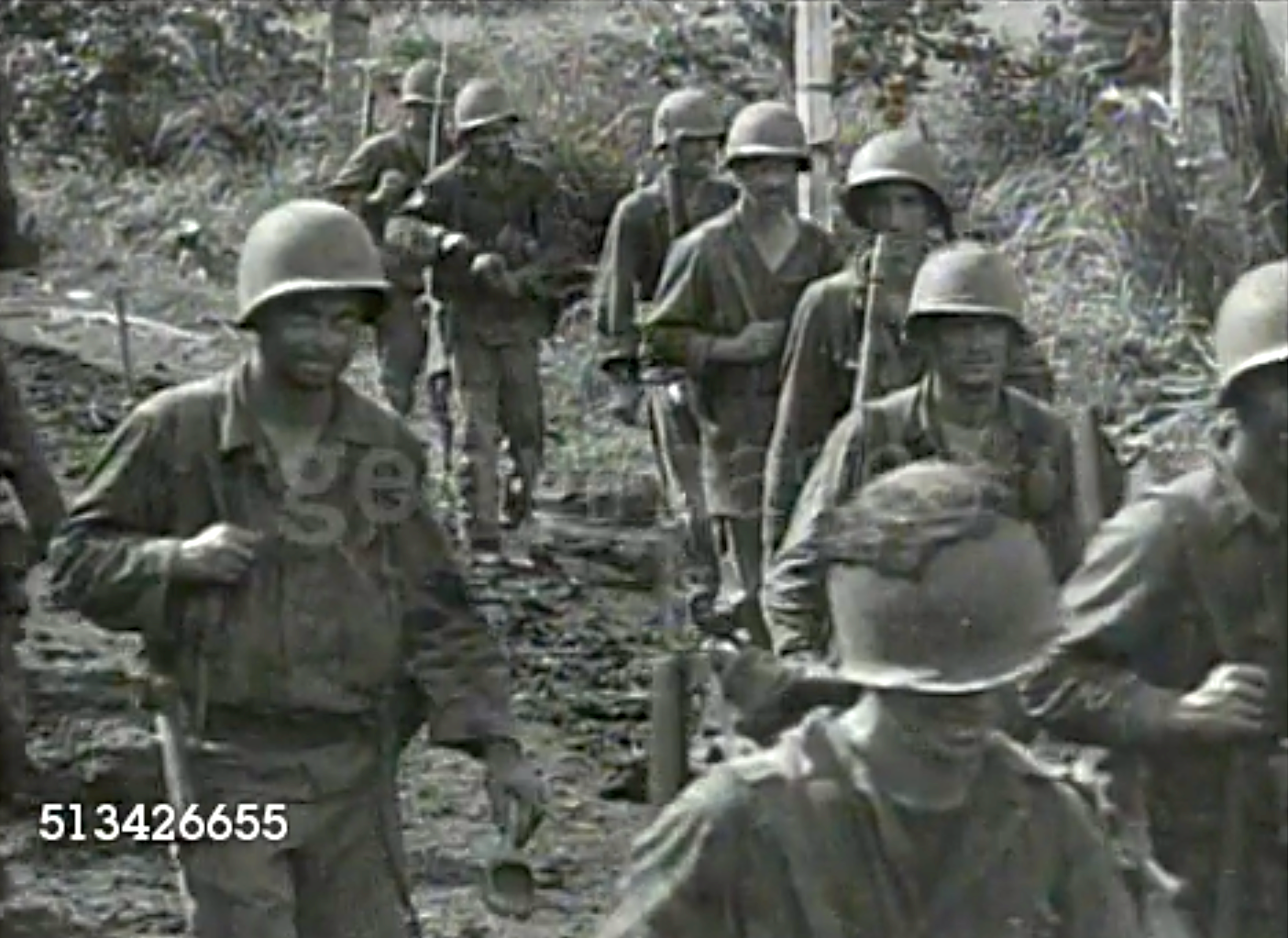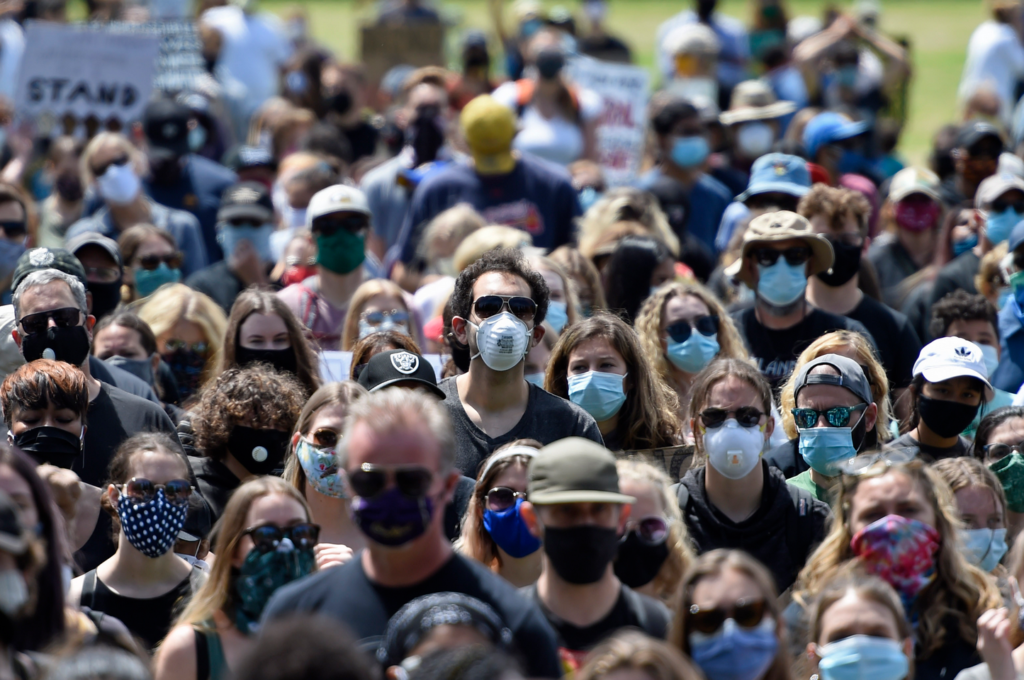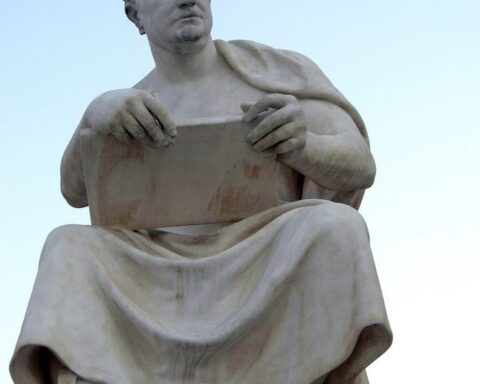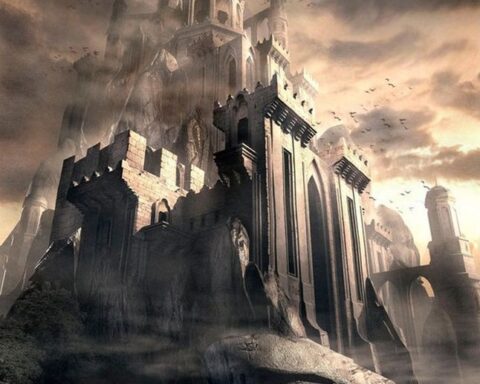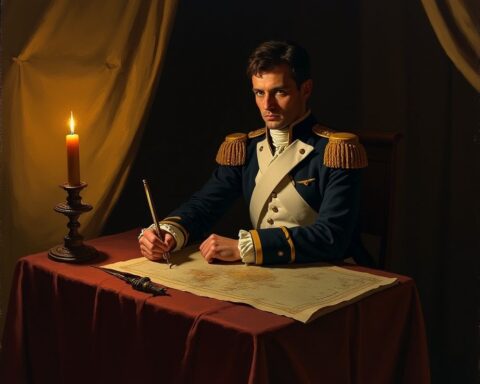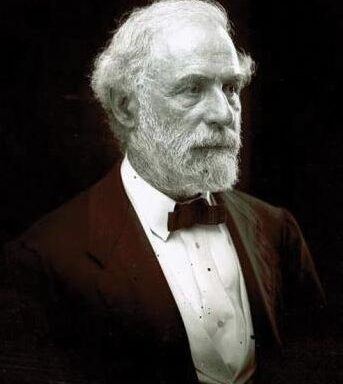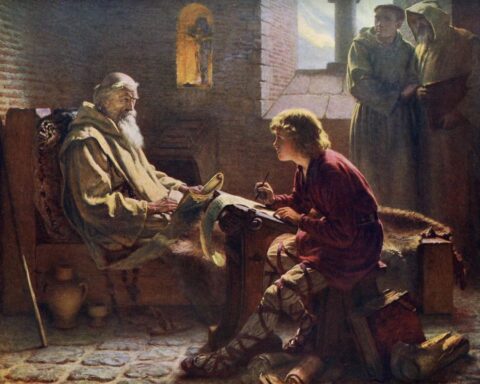Editor’s note: The following comprises Chapter 14 of Children of Yesterday, by Jan Valtin (published 1946).
(Continued from Chapter 13: The Breaking of Breakneck Ridge)
The Rock of Chickamauga,
The Nineteenth Infantry:
Brave her men,steadfast hearts
Known o’er land and sea.
Forward move her banners
Down through history.
Hail our Queen of Battles;
The Nineteenth Infantry.
(from “The Song of the Nineteenth Infantry Regiment.”)
“Doughboy White, Doughboy White, can you hear me?…. Can you hear me?…. Doughboy White…. Doughboy White….”
So headquarters of the Nineteenth Infantry Regiment in Pinamopoan called its Second Battalion on the night of November 9, 1944. Since November 4 the Second Battalion had been fighting on the wild slopes around Hill 1525, on Leyte, a thorn in the Japanese Ormoc Valley flank.
‘Doughboy White, Doughboy White, this is Doughboy Chief. Can you hear me? Over.”
From Hill 1525 the battalion’s commander, cool, lanky, sandy-mustached Lt. Col. Robert Spragins answered.
“Doughboy Chief, Doughboy Chief, this is Doughboy White. I can hear you all right. Over.”
In jungle darkness and mountain mists the walkie-talkies murmured like seasoned conspirators.
“…and due to transportation difficulties the kitchen personnel did not arrive. Last of rations were consumed for breakfast 9 November. The terrain was steep and difficult, exceedingly punishing for heavy weapons and communications personnel. Heavy rains and high winds became continuous and added to the difficulty of the march. The battalion bivouacked on the western slope of Hill 1525. Wind and rain continued to increase in fury, adding to the discomfort of the troops.”
(from a Field Report)
“Doughboy White…. Doughboy White….”
Colonel Spragins received the order to lead his battalion from Hill 1525 to a point 3,000 yards south of the town of Limon and 4,000 yards to the rear of the Yamashita Line. His mission was to throw a blockade across the Ormoc Trail which would prevent the Japanese from pouring reinforcements and supplies into Breakneck Ridge. Colonel Spragins asked for native guides. He also asked for rations. His battalion was under strength from twenty days of fighting since the Red Beach landings, and his men had not eaten for twenty-four hours.
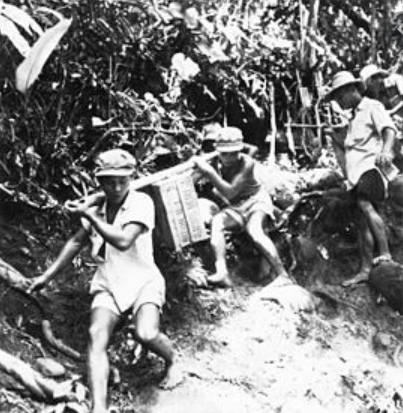
Three native guides arrived with a food carrying party shortly after noon. The food carriers brought slightly less than one ration per man in the battalion. It was all they had managed to pack over the mountain trails.
The battalion left Hill 1525 on the afternoon of November 10. It moved in a southwesterly direction in the wake of a vanguard platoon led by Lieutenant George Whitney of San Francisco. On the march the Californian had surprised and killed a Japanese captain in whose dispatch case documents of high intelligence value were discovered. The battalion marched for two days through constant rain and over a route which was frequently blocked by fallen trees and cliff-like inclines.
“There were no trails and it was determined that the command would avoid all open places and all well-used routes. Concealment was imperative because the unit felt the necessity of reaching its objective without dissipating its strength in combat en route. This resulted, however, in the pursuit of a circuitous route which taxed the endurance of the men to the utmost. The situation was complicated when native guides proved unsatisfactory and were unable to find trustworthy local civilians.
“With nightfall, ‘G’ Company bivouacked along a stream bed while the remainder of the battalion set up a perimeter on a high wooded slope. Available rations were opened. The men were hungry. Short rations and long marches were beginning to consume their strength. The men were ordered to make this ration issue last two days. After that the future would have to take care of itself.
“On 11 November, at 0600, a reconnaissance patrol located armed Japanese encamped 300 yards from our perimeter. An other patrol reported strong Japanese outposts 500 yards to the left of our route. They were armed with automatic weapons. A heavily wooded stream bed several hundred yards down the slope was chosen as a concealed route of advance. Leading elements were instructed to avoid contact with the enemy, or else to take steps to prevent the escape of contacted enemy personnel. The battalion resumed its march, cautious to prevent noise. At about 1600 eight Japanese approached within five yards of the column before they were seen. The Japs seemed bent on getting water and did not see the column until well directed fire caused their systematic destruction. Two were officers.”
(from a Field Report)
Sergeant Wesley Greer of Ft. Gibson, Oklahoma, was nibbling away at his last can of cheese when he saw a Jap in the jungle three yards away. In his excitement he took a large mouthful of cheese. He chewed it absent-mindedly while he raised his carbine, took aim and fired. As the Jap fell, Greer forgot about the cheese in his mouth and swallowed it. Later he looked at his almost empty ration tin, muttering that he’d like to know who had taken a mouthful of cheese out of his can while he had been shooting the Japanese.
“At 0700 on the morning of 12 November Colonel Spragins decided to follow a compass course. The guides were merely to pick the trail. At that time the battalion was on sloping ground about 1,500 yards east of the Ormoc Road and some 6,000 yards south of the coast. At 0900 it forded the upper reaches of the Leyte River and moved down a deep gorge, then followed a trail over a ridge to the west. The guides pointed out that it was probably a Jap trail. Seventy-five yards up the trail one of the Filipinos saw a Japanese in a stream bed and fired five shots before the platoon leader could stop him. The element of surprise was thus lost. Our scouts killed the enemy soldier.
“Fifty yards farther the scouts encountered ten more Japanese, apparently sent to investigate the firing. All of these were killed with rifle fire or grenades. Then the leading elements came under fire from positions up the slope.”
(from a Field Report)
The vanguard platoon pressed forward through bushes and high grass which limited visibility to about five feet There was a scattering of giant red lauan and molave trees whose trunks defied even the armor piercing bullets of the Garands. Lead scout was Private Brice E. Green of Raysal, West Virginia.
Silently Scout Green moved through the undergrowth; and suddenly he came upon a well-used trail. He signaled his platoon to a halt. The men crouched low, their rifles held ready for instant use. Green, standing motionless, searched every inch of terrain bordering the trail. From high ground beyond, the Japanese were pouring out a heavy volume of fire. But they were firing blind and their bullets went wide of their mark.
Thirty yards up the trail Brice Green saw a group of bushes strangely uniform in size. These were Japanese, camouflaged to look like bushes. Green prowled forward parallel to the trail. There were more enemies than his platoon could handle. He withdrew to make his report. He had saved his platoon from destruction. But no one mentioned that.
“George” Company’s commander, Captain William R. Hanks of Escabose, New Mexico, came forward to investigate the situation. He swung his assault force three hundred yards to the right and then led it against the flank of the defended ridge. Soon mortar fire burst into the skirmish lines. A horde of Japanese stormed down the hillside, throwing grenades. A wild, close-range fight ensued.
Private Joe Druse of East St. Louis, Illinois, killed three Japs with nine bullets at arm’s length.
Captain Hanks was running down the trail when suddenly he heard a scream close behind him. He wheeled and saw a Jap charging him with a bayonet. Hanks fired twice. His assailant rolled dead between his knees.
Sergeant Peter R. Slavinsky of Kulpment, Pennsylvania, saw a grenade plop on the ground two feet away from him. He had one second in which to act before the grenade would burst. He tossed it back in the direction from which it had come, then fired eight shots into a thicket. The result was a protracted groan and the sound of someone thrashing in the brush.
The battalion pushed through stubborn resistance and past many enemy corpses without having lost a man. From forward rang a glad shout. The spearhead had struck upon a hard-surfaced road — the Ormoc Valley Road. It was the only supply line available to Japanese forces fighting on Breakneck Ridge.
“That’s fine,” one officer said. “We’ve got ’em by their balls.”
Captain Hanks hurried forward. There was heavy firing which came from a hundred yards up another ridge on the far side of the road. There was a steep cut facing the road. It was impossible to scale the cut in a frontal assault. Colonel Spragins decided that a coordinated attack could not be launched without a thorough advance reconnaissance. It was 4 p.m. In two hours it would be twilight.
The battalion withdrew to the head of a ravine east of the road. Night perimeters were established and the men dug in. There was no supper that day. During the night artillery fire from friendly batteries on the coast pounded the Japanese positions. It prevented enemy counter-attacks during the night. Spragins’ radiomen carefully adjusted the barrage when shells menaced the battalion’s perimeter. A few of the shells burst in the crowns of huge trees near the perimeter edge. All night it rained. In the darkness the outposts could hear the rumbling of wheels on the Ormoc Valley Road — columns of horse-drawn carts moving northward to the Yamashita Line.
“At dawn, 13 November, patrols were sent along the ridges to observe the road and reconnoiter the flow of Jap strength.
“At 0745 they reported sighting a force of Japs moving from the north-west toward our perimeter.
“At 0800 another patrol killed a five-man Jap patrol. Knee mortar shells were falling around our perimeter.
“At 0930 a brisk fire fight developed on the perimeter with enemy forces of unknown strength. Several heavy machine guns and heavy mortars were identified, and several light machine guns. The Japs seemed bent on locating our positions, and determining our strength, for an attack in force. Our 60 millimeter mortars were effective in breaking up the attack.
“By 1100 fighting had died down.
“The men began to look for an air drop of food, medical supplies, and batteries for the radios of our artillery observers. None of the men had eaten for twenty-four hours. The effects of strenuous action over a long period of time made it apparent that if food was not forthcoming, the battalion could not function as it should.
“At 1300 the enemy sprayed our positions with machine gun fire and knee mortar shells, causing some casualties.
“At 1400 ‘Fox’ Company moved against the attacking Japs. Our counter-attack was made without supporting mortar fire be cause it was necessary to preserve what shells had been carried in by hand. The company ran into a heavy volume of mortar, machine gun and rifle fire and was called back from the direct attack. It was decided that the creeping and crawling method would be best for preservation of our men.
“The airdrop of supplies did not materialize by late afternoon and the battalion prepared to hold its position. As the day ended it became apparent that the enemy had solidly dug in across the battalion’s route of withdrawal to the coast. Some mortar fire was directed on the enemy block. A great amount of squealing and noise were heard as our shells struck.
“Our men stripped the hearts from young palms for food. Packs were stripped from the enemy dead and the men munched what rice they could find. Cooking fires were prohibited.
“There was no activity during the night, except that Japs were heard carrying away their dead. Heavy rains.”
(from a Field Report)
A soldier was struck in the face by a spray of mortar fragments. He suffered many cuts and holes. None of his wounds were fatal, but both of his eyeballs were punctured. The boy was blind. He would remain blind.
The medic who bandaged the blinded boy’s eyes and face knew that many days would go by before they would be able to get back to the coast. Until then the wounded would have to wait in foxholes, covered only with ponchos against the rain.
“Hey, Doc,” the blinded soldier asked. “Do you think I’ll be able to see again?”
The medic said slowly, “Sure… look, one eye isn’t so badly hit. Sure, we’ll be able to fix up one eye at least… after we get back.”
The blind boy was happy. Through his mask of muddy bandages his voice was cheerful. “Oh — that’ll be okay!“
Day after day of filth, hunger and hardship the medic’s white lie kept up the blind soldier’s morale. He would see again, would he not? On the long hike back he marched with the rest, and his buddies led him across the ridges and jungle ravines.
Then a Jap machine gun surprised them. The marchers dived into the jungle. All but the blind boy and the corpsman who led him. The blind soldier never knew that he would never see again. A Jap bullet pierced his heart. The corpsman, too, was killed and buried in the jungle.
“On 14 November, before dawn, a single shot was fired into the perimeter.
“At dawn our combat patrols moved out on the ridges toward the Ormoc Road, and another patrol reconnoitered the rear. In one small area investigated, thirteen Jap dead were counted. Their rifles, packs and equipment were recovered. Among the captured items was Jap dehydrated food and rice which our troops promptly consumed. Those still hungry breakfasted on pulp gleaned from small palm trees in the vicinity.
“At 1000 the Battalion Chaplain[1] held burial services for two men who had died of wounds during the night.
“At 1200 patrols returned. They reported having by-passed heavily armed Jap forces north-west of our positions. The patrols had found enemy communication wires running through a canyon. These wires were cut. Observation of the road showed numerous detachments of Japs moving in both directions. The patrols then discovered that high ground to the west dipped into a saddle toward the road. The sides of the saddle were 150 feet high. A patrol leader reported that the slopes on either side of the saddle could be scaled and that they would provide positions for the blocking of the Ormoc Valley Road.
“At 1345 came the first airdrop of food and supplies…”
(from a Field Report)
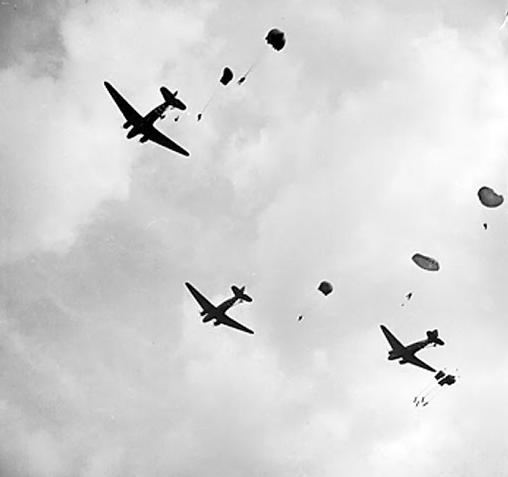
Soldiers weak from hunger watched the transport planes swoop low over the tree-covered ridges. The planes circled, uncertain of the isolated battalion’s position. The first drop of food and supplies fell into Japanese lines.
Field radios with near-spent batteries had difficulty in contacting the planes. The second drop was better. It fell fifty yards in front of the enemy positions.
Observers in the circling planes could see no trace of men in the wilderness below. Spragins’ soldiers stood strained, oblivious of the Japs. They watched the gray-green planes. The planes floated, their motors muted. Jap machine guns which at first had fired on the transports now held their fire. The planes passed directly over the battalion’s positions. Men shouted to the pilots: “Drop it! Drop it! God damn you, drop it!”
The third drop of food and supplies went entirely to the Japanese.
The fourth drop fell midway between friendly and hostile lines. After that the planes wheeled. Their motors roared as they disappeared in the rain.
Patrols were dispatched to fight for the supplies. “Bring in the radio batteries at any cost,” said Captain Hanks.
The jungle rang with the shots of skirmishers and the rataplan of machine guns. Sergeant Wesley Greer was disentangling a parachute from a case of supplies when a Jap attacked him from behind a tree. Greer slew the Jap and hastened away with the hundred-pound box. Joe Druse raised his score of dead Japs to fourteen. Private John Miller of the Bronx, New York, seized a package of batteries and fought for his life to get them through. An inventory after the “battle for the rations” showed that a few batteries, some medical supplies, sixty-four mortar shells and six cases of rations had been recovered. There were now available two hundred meals for seven hundred famished men.
“On 14 November, at 1400, a patrol returning from the south reported large numbers of Japs combing the hills for our supplies. The patrol found some of our rations and defended them until they could be brought in. All recovered rations provided the men with one third of one meal each.
“That night, friendly artillery, in an attempt to shell Jap positions on heights west of the road, dropped a round into the middle of our perimeter. It killed four men and wounded four. Liaison officers reported the incident and the fire was lifted. Colonel Spragins then decided to attack the hill south of the saddle the next morning without further preparatory fire.”
(from a Field Report)
November 15
An essential point in Colonel Spragins’ plan was never to reveal to the Japanese the full strength of his roadblock force. It was days before the enemy discovered the secret, and before he mustered overwhelming superiority of numbers and weapons against the isolated battalion. In the interval, Spragins achieved his goal — the strangling of hostile traffic on the Ormoc Road.
Patrols moved out at dawn. They ferreted out covered routes of attack upon “Saddle Hill.” They spotted a Japanese counter patrol which was crossing the road four hundred yards to the north. Sharpshooters killed all seven members of the counter patrol.
At 8 A.M. the battalion went into the attack. In order not to show his strength, Spragins ordered only “George” Company to consummate the assault. This team was reinforced by machine gun squads from companies “Fox” and “How.” The remainder of the battalion lay in hiding, with Major Charles Isackson, of Webster, South Dakota, in charge.
As the assault force pushed toward Saddle Hill, a violent fire fight sprang up in the battalion rear. Japanese detachments who had crossed a nameless tributary to the Leyte River attempted to scale a ridge and strike the battalion from behind. The thrust was repulsed.
In one of the encounters Major Isackson’s life was saved by Sergeant Edward Gauthier of San Antonio, Texas. The major stood near a fallen tree trunk eight feet in diameter. The sergeant saw a bush move, and yelled: “Look out!” The major ducked. An instant later a bullet crashed into the tree trunk inches above his head.
Joe Druse of East St. Louis raised his score of dead Japs to seventeen.
The advance against Saddle Hill proceeded. Avoiding the trails, the riflemen cut their way through jungle. At a stream crossing a Japanese sentry noticed the advance and began to run. Two scouts set out to “get the Jap.” The Jap was killed.
The spearhead reached the east shoulder of the Ormoc Road. Hanks reconnoitered for a good crossing. Then, stealthily, he deployed his command. A pillbox guarding the road was silenced with rifles and grenades. The leading platoon crossed the road at a rush. It reorganized on its western side under now heavy Japanese fire. The enemy fire came from Saddle Hill.
The spearhead platoon now formed a “beachhead” on the far side of the road to protect the crossing of the main assault force. “George” Company’s men crossed the road at a run, one man at a time. They formed a skirmish line and pushed uphill, but were stopped by machine gun fire from camouflaged strongpoints flanking the saddle. Southward along the highway, Japanese bivouacs and supply dumps were visible. A number of “George” Company soldiers were hit. Captain Hanks called for mortar fire on the hill top positions.
While “George” Company riveted the Japs’ attention, Spragins ordered “Easy” Company to assault the northern hump of the saddle. This second team crossed the road at 3 P.M. in swift rushes. It charged up Saddle Hill and put the defenders to flight.
“George” Company disengaged under heavy enemy fire which came from the south, and joined “Easy” Company on the captured saddle. In the rough terrain the evacuation of the wounded was a nightmare. Japanese snipers and machine guns fired relentlessly at the wounded men and at the men who evacuated them. A corpsman working to aid the wounded was killed. Three of the wounded soldiers were killed. Another corpsman helping along a wounded sergeant was critically hit.
At 4 P.M. the two companies dug in on Saddle Hill. From their position they looked directly upon the Ormoc Road. At one point the road was only ten yards from the perimeter. This was called the West Perimeter.
Major Isackson was instructed by radio to have the remainder of the battalion dig in secretly on a ridge on the east side of the highway. This position was called the East Perimeter.
Night fell, dark and menacing. Rain fell steadily on the strained men. In muddy foxholes the wounded were quieted with morphine. But Nippon’s gate to its fighters on Breakneck Ridge was blocked.
Radio contact was established with another of the Division’s battalions which was hacking away at the enemy’s flanks west of the roadblock.[2] Colonel Spragins discussed the possibility of using the brother battalion’s lines of communication to bring in supplies for his own force. But patrols dispatched to make contact with the other battalion returned with their mission uncompleted. They reported masses of Japanese entrenched on the ridges west of the Ormoc Road.
“Shortly before midnight the roadblock bore its first fruit A number of trucks approached the block from the south. Visibility was nil because of pitch darkness.
“Our heavy machine guns opened fire when the gunners thought that the convoy was in range. Range was estimated by the sounds of wheels. There was considerable commotion, with Japanese squealing, shouting and running up and down the road in the area of fire. Apparently the trucks were carrying troops and the Japanese were removing their dead and wounded. The convoy backtracked and did not attempt to force the block. Four of the vehicles were found destroyed.
“Our machine gunners then held their fire. They, as well as the riflemen on the perimeter had been instructed to fire only when they were certain that their fire would be remunerative. Thus the enemy was kept in doubt as to the exact location of the block and as to our exact strength.
“At 0300, on 16 November, a Jap troop column was heard moving north on the Ormoc Road. Our machine gunners opened up when the head of the column had advanced to the point where fire could be brought to bear with maximum effectiveness. An unknown number of casualties was inflicted. There was much confusion on the road. Later small groups were heard to drag away the dead and wounded. Remnants of this column, scattered along the road at daybreak, were picked off by our rifle men.
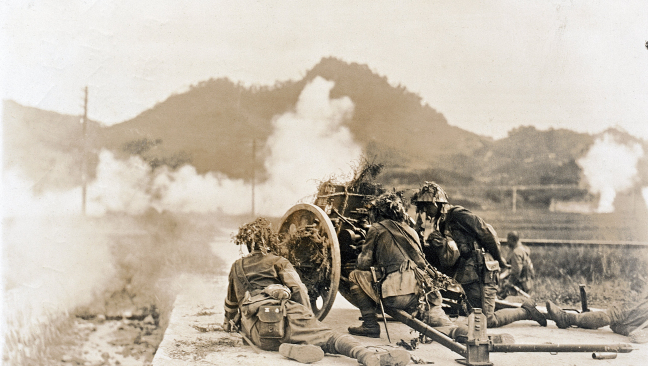
‘Two Japanese 75 mm. field pieces north-east of the block went into action. At 1100 friendly artillery registered counter-fire. The perimeter rocked with the blasts, straining the nerves of the men to the breaking point.
‘The men had not eaten in 27 hours. Many were so weak that they could not walk from the bottom of the perimeter to the slopes of the saddle. They had lost their sharpness and did not retain enough reserve strength to dig in as they should.
‘Two patrols were sent out to attempt contact with the First Battalion, 34th Infantry Regiment, believed to be on Kilay Ridge 1,000 yards to the west. The intention was to arrange for supplies and for the evacuation of our wounded through their means of egress. The patrols returned to report that the ridges and valleys between the perimeters were infested with Japanese and woven with well-used trails. Contact was finally made by radio. We were informed that the supply lines of the Thirty-Fourth were strained, that they could not provide rations, but that they would attempt to evacuate our wounded.
“The Battalion Surgeon[3] was in the East Perimeter and adequate medical attention was not available for the wounded in the West Perimeter. The crossing was hazardous. It was attempted three times, and each attempt resulted in fights with the enemy and in casualties to our own troops.
‘The wounded lay in foxholes, exposed to the rain, uncomplaining. But their suffering added to the depression of those still able to carry on. All knew that the number of casualties would steadily increase, with little chance for evacuation.
“Hopes were fanned by a radio report that a carrying team composed of Cannon Company volunteers was fighting its way through the mountains to bring us rations.
“Drinking water was scarce. The nearest supply was at the bottom of a hill to the north. It was necessary to send patrols to protect the carriers. Helmets were used for the transport of water because canteens clanked too loudly when the containers struck one another. The first cases of dysentery appeared among our men.
“After artillery fires had lifted with the silencing of the Japanese 75’s to the north-east, another enemy artillery piece opened fire at 1300. The field piece was situated about 200 yards south west of the perimeter. Lieutenant Whitney called for machine guns. The gunners were knocked away from the gun and many Japs were seen to flee the area; 81 millimeter mortars were then zeroed on this position and fired several rounds. Japs were heard to scream. There was no more fire from this field piece for the rest of the day.
“Enemy machine gun and mortar fire continued on the road block throughout the day. Our riflemen were active. Sniping at Japanese stragglers on the road continued.
“Also at 1300 an enemy truck convoy attempted to run the block. It was stopped by concentrated fire. Twenty Japanese were killed.
“At 1455 it was learned that the Cannon Company carrying party had arrived in the vicinity with a supply of chocolate bars and cigarettes. Difficulty was experienced in guiding them to the roadblock.
“At 1500 an airdrop by B-25 planes materialized in the vicinity of the East Perimeter. A part of these rations was recovered.
“At 1530 ‘G’ Company dispatched a six-man patrol to the East Perimeter to escort a carrying party bringing airdrop rations to the West Perimeter. The patrol was led by Sergeant Underwood.[4] On the way out the patrol engaged in a fire fight and killed three Japs. The patrol then crossed the road and met the ration carrying party. On their return trip, just before they reached the road, patrol and Cannon Company food carriers were caught in hostile grenade and mortar bursts. One man was killed and one wounded. Sergeant Underwood returned to the West Perimeter alone to inform us of the situation. We placed mortar fire and machine gun fire on the Japs. The carrying detail crossed the road, protected by Sergeant Underwood’s patrol. Japanese mortar fire then dropped in the West Perimeter, killing two message center men and showering the battalion commander and his staff with earth. Raking hostile machine gun fire wounded several other men on the perimeter. The radon party had lost one third of their load during the fight. The rations secured provided almost one full meal per man, plus ten chocolate bars for each. It was the only meal the men had in forty-eight hours.
“Because of the confusion and oncoming darkness it was decided not to hunt for the lost rations until the following morning. The men had the satisfaction of knowing that they would guard them and eat them later. That knowledge, plus one full meal, gave us a new lease on life.
“The night was relatively quiet. Heavy rains. Some of the wounded men died of their wounds and of exposure. Our cemetery in the West Perimeter is beginning to occupy more than its fair share of the area.”
(from a Field Report)
Three Americans went prowling in the jungle for scattered airdrop rations. All three were hungry and they were determined to eat. They scoured the hillsides and ravines, until they saw the gleam of parachute cloth in a tangle of vines. There lay a ration box on the near slope of a gully, and a second box lay on the opposite slope. As the three soldiers approached the first case of food, they saw a group of Japs push through the jungle on the other side of the gully. The Japs were intent on the second ration box which now lay almost at their feet.
The Americans did not fire. At this time food was more important to them than dead Japs. They would not risk to lose it in a fight. They grasped the ration case on their side of the gully and plunged back into the jungle. The Japanese were of the same mind. They, too, secured a box and vanished without firing a shot.
Sergeant Robert R. Wickey of Muscatine, Iowa, also went prowling. But when confronted with the choice between carrying back food or radio batteries — he chose the batteries. Without batteries the battalion would be unable to direct the fire of the Division’s artillery on the far side of Breakneck Ridge; and unable to warn their cannoneers if their shells should strike a friendly perimeter.
From their perch on Saddle Hill two scouts looked out across a narrow valley. Beyond the valley lay another ridge. A trail led up this ridge. The scouts saw a lone Jap toil up this trail. The Jap was carrying something that looked like a wooden cart wheel. He was followed by two other Japanese who were lugging the barrel of a cannon. The ends of a pole thrust through the bore rested on the carriers’ shoulders. Then a train of other carriers appeared, all muscling parts of a heavy field piece to the summit of the ridge.
The scouts reported what they had seen. A machine gun manned by Sergeant Kleetis Ivey of Careyville, Tennessee, was brought forward and mounted on Saddle Hill. Bursts of long-range gunfire scattered the train of bearers.
When Sergeant Jesse Underwood and his patrol, escorting the ration party, reached the West Perimeter after their encounter with a Japanese ambush, Underwood did not stay. Alone he cut back into the jungle to look for the soldier who had been wounded in the clash. He found the wounded man hiding in the roadside ditch. The road was teeming with Japanese. Under wood rushed forward and dragged his disabled comrade away from the road.
During another patrol skirmish that day, a soldier fell and was left for dead outside of the perimeter. His comrades later heard him shout for help. Private James Gilgen of Chicago went out alone into the jungle and rescued him.
And Joe Druse of East St. Louis raised his score of dead Japs to twenty-three.
“On November 17, at 0700, riflemen on the roadblock detected a force of Japs attempting to filter past the block. Firing was regular throughout the morning. Japs were trying to reach an ammunition dump which they had abandoned near our perimeter. Enemy patrols approached the perimeter from all sides, apparently to test its strength.
“An airdrop materialized shortly before noon. We recovered eighty-three boxes of rations. There was great rejoicing. Some men fell unconscious while eating. Colonel Spragins and other officers and soldiers had given their previous rations to the wounded.
“The rations had fallen near the East Perimeter. Again there was the problem of bringing the West Perimeter’s share across the Ormoc Road. The Cannon Company carrying party reinforced by riflemen succeeded in the mission, after a brief fire fight. No batteries were recovered from the airdrop. Our artillery radios were about off the air and the generator of our 284 radio in the East Perimeter had succumbed to rust.
“At about 1530 two Japanese tanks, heavily camouflaged, with boxes of supplies strapped to their sides, moved past. Our bazookas did not have a chance to fire. At 1700 these tanks returned and were taken under fire. One tank was hit.
“At 1630 the hostile artillery piece to the north-east shelled the perimeter. It was silenced by fire from friendly batteries. The explosions sprayed the West Perimeter with shell fragments. No further attempts were made by the enemy to move troops or supplies through the roadblock.
“The night was uneventful. Rain.”
(from a Field Report)
Sergeant Peter R. Slavinsky of Kulpment, Pennsylvania, led the patrol which carried airdrop supplies into the West Perimeter. Every man in the patrol was heavily loaded. After they had pushed some three hundred yards through rugged jungle land, there was a shout. A Jap leaped from a tree and ran, shouting an alarm. Scouts fired by sound and missed. Then Japanese machine guns and rifles clattered on a steep incline on the left. The patrol dived to the ground. The men crawled into a mud-filled draw where they reformed. But one of the food carriers had been shot through the back. He had fallen across a log and now lay exposed to Japanese bullets which whirred through the underbrush like steel locusts. Peter Slavinsky crawled through gunfire until he reached the log. He pulled the wounded man down to the ground. Then he dragged him into the draw. He was carried to cover on a quickly fashioned bamboo litter.
“On November 18 we received word that the Twenty-First Infantry Regiment on Breakneck Ridge had been relieved by elements of the Thirty-Second Infantry Division. We also received word that a battalion of the Thirty-Fourth Infantry Regiment was pushing through the mountains from Pinamopoan to bring us supplies and to evacuate our wounded.
“At 0730 we sent out a patrol to contact the relief party. Near the Leyte River this patrol came upon fourteen Japs who were cooking rice, and killed them all. Later the patrol contacted the relief force and guided it to the East Perimeter after a fire fight with surrounding Japs.
“This was a harassing day. Friendly artillery shells fell in the vicinity of our perimeter off and on throughout the period, showering both perimeters with shrapnel which caused many wounds. We tried frantically to contact the artillery positions, but the batteries in our radios were gone. Finally a message got through and the fire was lifted about noon. However, later in the afternoon the fire and shrapnel started again. It appeared that our positions were not clearly located because of the inaccuracy of all maps.
“There was sniping throughout the day. A number of Jap infiltration groups were wiped out. Some of them were still trying to reach their ammunition dump. We removed the dump and buried the ammunition behind our perimeter. It consisted of quantities of mortar shells, artillery shells and TNT.
“Twice a day we sent security patrols to a stream at the bottom of the ridge to protect our water carriers. Water was carried in helmets. Some Japs interfered near the watering point. They were killed.
“We still felt that the enemy had been unable to locate our exact positions, or to determine our strength. That saved the lives of a large percentage of our command. Daily the Japs at tempted to discover our strength with the apparent intention of sending a force sufficiently large to immobilize us. On two occasions Japanese officers were killed trying to infiltrate our perimeters. By never showing his hand, Col. Spragins was able to kill many Japs in their attempts to erase his command.
“An airdrop was made during the afternoon. It was a poor one. Much of the supplies went to the Japs. We sent out patrols to recover as much as we could. So did the Japs. Two Japs were killed in a patrol fight over rations.
“At 1700 a Japanese troop column appeared on the road. It was dispersed by our fire.
“At 1730 a carrying party came to our perimeter with 33 cases of rations.
“Japanese artillery to the north-east fired into the perimeter. It was silenced by battery fire from our 60 millimeter mortars.
“Then the Jap artillery piece south-east of the perimeter opened fire. Two shells dropped in the West Perimeter, wounding several men, two seriously.
“At 1930 a sheath of friendly artillery bracketed the West Perimeter. One shell went over, one fell short. The third landed in the center, killing five men and wounding nine. One of the wounded men died later. Fortunately, an observer with the carrying party had contact with the unit firing. The fire was lifted.
“During the night Jap tanks passed the roadblock on three occasions, and returned. They apparently carried ammunition to the artillery in the north-east. The last of our bazooka ammunition was expended on them. Some hits were scored.”
(from a Field Report)
About a trek of the relief party which marched from the coast through Japanese lines to rescue the wounded men of the ”lost battalion,” the Division Record states:
“The party left Pinamopoan on the morning of 16 November under the guidance of men who previously had charted a trail to the roadblock positions. The party spent the first night in the mountains south of Pinamopoan. On 17 November it resumed its march over rough terrain, by-passed strong enemy positions and continued until 1600 when an artillery shell wounded one man. An hour later the center of the column was attacked by a force of Japanese. Three men were killed in the ensuing action and eight wounded. Five of the wounded became litter cases and had to be carried the rest of the march. After swinging far around the danger zone, the party bivouacked for the night. On the following morning patrols of the party contacted roadblock patrols in the vicinity of the Leyte River.”
Two small advance patrols which charted the relief party’s course across the mountains were led by Sergeant Dave J. Boland of Portland, Oregon, and by Captain Brian Walker of Mount Pocono, Pennsylvania. A report by the Oregonian’s comman ing officer describes the feat:
“Sergeant Boland led a patrol to an Infantry Battalion behind the enemy lines. The climatic conditions during this period were extremely severe and travel difficult. Storms erased all traces of the route of march of the battalion. Since the battalion was completely surrounded, it was necessary for this patrol to pass through the lines of the enemy besieging the hill held by our troops. Despite these obstacles, Sergeant Boland located the battalion. His superior judgment, courage, initiative and quick thinking were responsible for the accomplishment of an urgent mission.”
And here is an official description of Captain Walker’s patrol:
“Captain Walker personally led a patrol to locate friendly elements that had been cut off and were without communication. The patrol had to go through enemy held territory and was twice challenged by enemy sentries, but skillful maneuvering enabled the patrol to elude the enemy. The patrol discovered and recorded the location of enemy machine gun positions which were later destroyed. It cut enemy communication lines on two occasions. After an eight-hour march the patrol finally located the isolated battalion and re-established communications. On the way back the following day, the patrol was harassed by enemy artillery fire.”
“At daybreak, 19 November, Jap artillery to our north-east opened fire. We directed fire on the enemy position. It was silenced.
“At 0800 preparations were made for the evacuation of our wounded. Distribution of rations gave about two days’ food per man. Litters were improvised from saplings and sections of parachute cloth salvaged from the airdrops. Most of the wounded had lain in their foxholes for days. Asked how they felt, they simply replied, ‘Okay.’
“The Battalion Surgeon, Captain Edward L. Croxdale, worked without regard for danger or his own physical limitations. During thirty-four days of campaigning, in which the battalion was in almost continuous contact with the enemy, Captain Croxdale was the only medical officer present. It was only through his untiring efforts that many of the wounded were evacuated in such a condition that their lives could be saved. He worked tirelessly, day and night, always without complaint, and under the most adverse conditions.
“At all times food was short, or non-existent. Medical supplies could be obtained only through airdrops. It was necessary for some of the wounded to be treated for ten days inside the battalion perimeter. Operations upon them were performed by flash light under ponchos.
“At 1030, as we were working over the wounded, the Jap artillery piece to the south-east opened up. We silenced it again with heavy mortars.
“At 1330 the carrying party departed with a burden of 23 litter patients and 27 walking wounded. We wished them luck on their march through the Japanese lines.
“At 1530 the Jap artillery to the north-east and south-east opened up. There was considerable tension among our men. We laid mortar fire on the pieces. We then discovered that the Japs had dug a third artillery position. Our mortar fire succeeded in keeping it silent. However, their other field pieces fired intermittently.
“During our fight with the Jap artillery, four Japanese tanks passed the block running north. We had neither anti-tank mines nor bazooka shells. As the tanks passed they raked the perimeter with machine gun fire. Twenty minutes later they returned, going south. This time they added cannon fire to machine gun fire. One shell cut down a large tree. Another penetrated five feet of earth and exploded in a foxhole. One man was killed, four wounded.
“After the tanks had passed, a column of Jap soldiers approached the roadblock from the direction of Breakneck Ridge. The enemy soldiers moved slowly. They appeared haggard and worn out. After they came into the line of fire, our machine guns opened up. The column was dispersed. The survivors milled in confusion. They attempted to reform, but were again dispersed by our mortar fire.
“During the night Japs on the road threw grenades into our perimeter. Otherwise the night was relatively quiet. Heavy all-night rains.
“Early during the morning of 20 November we received a radio order to withdraw the battalion to Hill 1525.
“Shortly before daylight there was the sound of rifle fire on the perimeter. A Japanese force had infiltrated during the night while most of our men were under their ponchos to escape the rain, with only the guards on the alert. Our men were alerted by the guards. The Japs threw many grenades. Our defense was effective and many enemies were killed. A number of Japs were killed inside of the West Perimeter. The fight continued for an hour.
“Col. Spragins sensed that this attack was but a diversionary move. He immediately reinforced other sectors.
“Before the first attack had ended, a large force of Japs savagely attacked the East Perimeter. The attackers were discovered by an outpost before they reached the top of the ridge. Some of our outposts were killed by Japanese machine guns. As the enemy charged in a Banzai assault he was met with hand-grenades, machine gun fire and mortar shells. Our mortars laid fire on the Japs within twenty yards of our perimeter. More than one hundred Japs were killed. Sniping continued until noon.
“At 0800 a third Jap force attacked another section of our perimeter. Our outposts withdrew fighting. Our mortars went into action to break up the enemy concentrations. They broke with a great amount of yelling and squealing. As the assault closed in, our riflemen killed off the first wave of Japs. The fight lasted until 0900.
“At 0900 a fourth attack struck the perimeter. This appeared to be the main Jap effort. The Banzai sounded on a line hundreds of yards long. The enemy gathered at the foot of Saddle Hill which was too steep for our mortar fire to become effective. The first wave of Japs was killed, but they continued to come. One platoon of ‘G’ Company killed seventy Japanese. At times it seemed that the order for the withdrawal of the battalion had come too late. But after 45 minutes the Japs decided they had had enough.
“At 1000 patrols pushed to the Ormoc Road to secure the withdrawal. ‘G” Company acted as the rear guard. The battalion then crossed the road, one man at a time, at a run.
“At 1230 the West Perimeter force had successfully joined the East Perimeter group. Strong Japanese forces were reported to be within two hundred yards. Col. Spragins decided to follow the route of the party which had carried out most of our wounded, on the chance that this party might have encountered trouble.
“At 1300 the battalion moved east toward the Leyte River. The river was raging, swollen from rains and bedded with elephant-sized rocks. The water was too swift for footing. Speed in crossing the river was imperative in that we were still far behind the enemy lines.
“Bamboo vines were tied together to make a staunch rope. A chain of men was formed. The battalion commander crossed the river and tied the vine rope to a tree. The other end of the rope was secured on our side of the river. The battalion commander then re-entered the water to help in the crossing of the helpless wounded. The battalion crossed with the aid of the bamboo rope. The crossing was completed at 1600. A check disclosed that not one weapon had been lost or abandoned, including the heavy weapons, and that all packs were still being carried by the men.
“The battalion moved to high ground and dug in for the night. The night was quiet. Heavy rains.”
(from a Field Report)
On that day (November 20) Sergeant Wesley Greer stood up right on the perimeter in machine gun and mortar fire. The morning’s Banzai attacks were at their height. He stood upright because he was so better able to direct the defensive fire of his men in the foxholes. Also, he killed three Japs with his rifle and with grenades.
Sergeant Robert B. Hanseen of Scipio, Utah, was a company clerk. But when the Banzai rushes swirled around the isolated battalion, he joined the fight. “By a masterful use of his rifle,” his commanding officer said later, “and accuracy in throwing fifteen grenades, Hanseen was instrumental in stopping the assault.”
Later, as the battalion moved, an outpost at the foot of Saddle Hill fell in a burst of Japanese machine gun fire. From a distance it was not possible to tell whether the soldier was alive or dead. He had fallen into a gully covered by underbrush. Hanseen volunteered to go into the draw and find out. While he was on his way the Jap gunners fired again. Hanseen was gone for many minutes. When he reappeared, scrambling up the slope, he carried the outpost’s Tommy gun. He reported that the man was dead.
On that day, too, Captain Lamar Clark of Huntsville, Texas, the Battalion Chaplain, walked into a lane of Jap machine gun fire. One bullet passed through the seat of his trousers.
Rifleman Joe Druse had meanwhile raised his score of killed Japs to thirty.
“On 21 November, at 0700, the battalion resumed its march toward Hill 1525. The terrain was difficult and progress slow. After proceeding about 1,000 yards, Col. Spragins was informed by a native that American soldiers had passed here at noon of the previous day. That was the first sign we had of the party which carried most of our wounded.
“At 1300, about 600 yards up Hill 1525, we heard the sound of firing. The column halted.
“A Japanese force had waylaid the carrying party. Heavily burdened with wounded, the party did not have sufficient rifles to deal with the enemy. We joined forces.
“The relief party under Major Carl E. Mann[5] brought back twenty-six litter casualties and forty walking wounded. Its entire route was through enemy held territory. There were heavy rains throughout its four day march. There had been only two days’ rations available to the party. On two occasions the party received heavy attacks from enemy groups in ambush armed with rifles, machine guns and mortars. There were seven men killed and sixteen wounded in these actions, but Major Mann was able to evacuate all the wounded while protecting the remainder of the party.
“Progress had been slow and laborious. At times litters had to be passed from hand to hand when terrain became too hazardous for routine carrying. The litters could be carried only a short distance by the tired bearers before being turned over to a relief group. Walking wounded had to be frequently assisted over precipices and fallen trees. Some of them should have been carried on litters, but they insisted on walking to ease the burden of the bearers.
“A Filipino volunteer guided us around the Jap positions. We had contacted by radio a friendly force on Hill 1525, and asked them to fire a machine gun burst. The shots sounded close and we had hopes of reaching friendly positions that day. But the tortuous terrain forced us to spend the night in the jungle of the lower slopes.
“Most of 22 November was taken up with moving the litters to the crest. The advance units started at 0700. The rise was too sharp to be scaled by the bearers with their burdens. The litters were passed uphill along a human chain formed by all men. “By nightfall most men had not eaten for 48 hours. The wounded had been without food for 24 hours. The bearers had given their last food to the wounded. Many of the men were without shoes. Jungle boots had torn and fallen apart. Many wore shoes taken from Jap dead. Some of the shoeless men with bruised and ulcerated feet had to be carried by comrades. There were 153 cases of jungle rot, foot ulcers, dysentery and fever. “At dawn, 23 November, the column moved out toward Pinamopoan. Patrols reported that Jap forces were active in the mountains between Hill 1525 and the coast. Three companies of rifle men were sent ahead to clear the trail. The litter column followed, and two rifle companies formed the rear guard. Each litter was allotted a carrying force and a group of protecting rifle men. Progress was slow. The litter column drew fire but was able to shift its route and push through to the coast. However, the column of walking wounded was halted. Two of the group were killed and three wounded by knee mortar shells. Enemy fire ex tended over the greater portion of the trail. A walking casualty and the soldier leading him were killed by a sniper. The walking wounded and some of the litter patients with protecting units then returned to Hill 1525 for the night. One litter patient died during the night.”
(from a Field Report)
Corpsman Leo J. Kintana of Martinez, California, was leading two wounded soldiers when the Japanese attack cut the relief column in two. Protecting riflemen fanned out to engage the Japs. On the rough hillside the wounded were unable to move alone. Kintana remained between them. He slung one arm of each wounded man around his neck and shoulders and carried his double burden to the cover of a ravine. A sniper climbed a tree overlooking the ravine. His first bullet fatally wounded one of Kintana’s wards. The rest of the column had withdrawn. Kintana was alone with one dying man and one disabled. He fought it out with the sniper. His fatally wounded comrade had died. Kintana then gave his remaining patient blood plasma to bolster his strength, and led him to the perimeter on Hill 1525. When Japanese mortar shells killed two and wounded three men in the relief column, Corpsman Richard R. Smith of Atlanta, Georgia, sprang through shell blasts to the aid of the wounded. He bandaged their wounds and gave them sulfa. Then he fought his way alone through snipers’ nests to Hill 1525. He returned with a patrol and found the wounded and rescued them.
“On 24 November the column pushed through to Pinamopoan. After their arrival, the men were forced to walk more than a mile to Pinamopoan Point because enemy machine guns prevented the use of landing craft close to the shore. The wounded were immediately evacuated. Two hundred and forty-one of the battalion’s officers and men were hospitalized. The men were given their first cooked meal in fourteen days: peas, carrots, bully beef and coffee. It was Thanksgiving Day.
“The battalion killed 606 Japanese during its mission. The men felt that their fire had accounted for many more, although a complete count could not be made because of the nature of the terrain and the fact that the Japs removed their dead whenever they could.
“The battalion rejoined its regiment at Tanauan and at once began to stage for the invasion of Mindoro Island.”
(from a Field Report)
(Continue to Chapter 15: Dragon Red)
______________________________________
[1] Captain Lamar Clark, of Huntsville, Texas.
[2] This was the First Battalion of the Thirty-Fourth Infantry Regiment, commanded by Colonel Clifford, which had occupied Kilay Ridge in the rear of the western sector of the Yamashita Line.
[3] Captain Edward L. Croxdale of Villisca, Iowa.
[4] Sergeant Jesse J. Underwood of Camp Taylor, Kentucky.
[5] Major Carl E. Mann of Clayton, Alabama.

